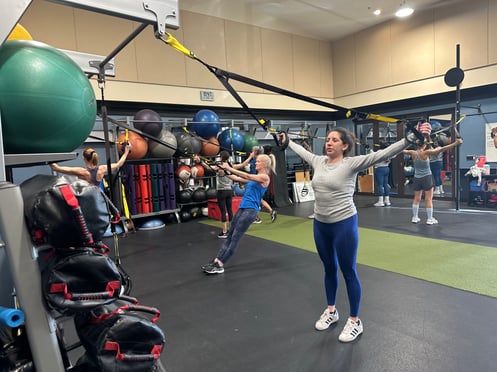High-intensity exercise: how much is too much? (High-intensity classes at the Paseo Club)
February 10th, 2023 | 5 min. read
By Jen Azevedo
In the quest to get fit (or fitter), people are looking for the most effective trends in exercise. High-intensity training has received a lot of attention because it is efficient, helping people lose fat and build lean muscle.
But not everything about high-intensity training is great — there are risks.
Exercise can become an obsession to stay lean, keep up with friends, or maintain the fitness level of your younger self. But when you perform high-intensity workouts in excess, you risk overdoing it, leading to fatigue, apathy, and even injury.
The Paseo Club is a social club with almost 20 years of experience supporting health and fitness goals of our members. We offer a range of classes for all athletes — cycle, Pilates, Zumba, yoga, barre, and high-intensity training.
In this article, we will explain what high-intensity exercise is, the benefits and risks, and the right amount of training for you.
What is high-intensity exercise?
High-intensity exercise is defined as performing vigorous exercise. Well, how do you know for sure that your exercise is vigorous?
There are three ways to assess the intensity:
1. Talk Test
A simple method to assess exercise intensity is by using the talk test. You are engaged in high-intensity exercise if you can barely utter a few words before you have to stop and breathe.
2. Heart Rate
Your heart rate will increase in proportion to the intensity of your exercise. Track and guide your exercise intensity by calculating your Target Heart Rate (THR) range. Heart rates increase by 80-90% when performing high-intensity exercise.
3. Intensity Scale
Another system for self-assessment is the intensity scale. The scale, developed by a Swedish researcher, is between 6 and 20. A 6 on the scale is a person sitting or standing at rest. An easy pace of movement is a 9, moderate exercise is 12-14, and 15 and higher is in the vigorous exercise zone.
Signs of vigorous (high-intensity) activity is defined by it being difficult to impossible to speak, you are sweating, and it is challenging to work and maintain the current level of exertion.
What exercises are considered high-intensity?
The majority of high-intensity training falls under the category of HIIT (high-intensity interval training). HIIT involves repeated bouts of high-intensity anaerobic effort followed by short periods of recovery.
Several movements can make up a HIIT workout.
- Burpees
- Air jacks
- Thrusters
- Box jumps
- Jump squats
- Animal crawls
- High knee run
- Speed skaters
- Clean and jerk
- Clean and press
- Explosive lunges
- Explosive push-ups
- Sprints — running, biking, or rowing
- Double under (or single) jump roping
How do high-intensity exercises benefit health, athletic performance, and weight?
The underlying principle of HIIT workouts is to train hard, close to maximal capacity, rest a little, train hard, rest a little, and repeat.
HIIT is training that begs exercisers to go hard or go home, regardless of the activity. The best news is that if you are strapped for time, HIIT has been proven to not only torch calories, but also enhance your aerobic capacity without the long (sometimes boring) workouts.
High-intensity benefits health
High-Intensity exercise reduces the risk of chronic diseases. It also can improve blood pressure, mental health, cognitive function, well-being, and quality of life.

High-intensity benefits athletic performance
High-intensity exercise elicits larger responses at the cellular and molecular levels. This leads to significant improvements in fitness and health-enhancing benefits.
People who do HIIT have more strength and stamina for other activities and sports that they participate in.
High-intensity benefits healthy weight
High-intensity physical activity can lead to more weight loss because it burns more calories in less time.
Can everyone do high-intensity exercise?
While HIIT is a great option for folks already in shape, the majority of the population reportedly finds it unpleasant and, thus, unsustainable.
This is a problem.
HIIT is not easy. When people view exercise as a task, as opposed to an enjoyable activity, they're less likely to do it. Find something you enjoy doing that you will do with regularity and consistency.
If you enjoy HIIT and have no pre-existing health conditions, you can attend HIIT classes in moderation.
What happens when people do too much high-intensity exercise?
High-intensity exercise is demanding in a way that low and moderate-level intensity is not. If you participate in HIIT too frequently, you run the risk of overexerting yourself, which leads to side effects.
Common symptoms of HIIT overtraining include:
- Lack of sleep
- Chronic fatigue
- Increased injuries
- Diminished motivation
- Blood sugar dysfunction
- Pain and swelling in the joints
- Reduction in strength and performance
How much high-intensity exercise is the right amount? 
The general rule is you should allow 48 hours between high-intensity sessions, avoiding back-to-back days of HIIT.
- Children ages 6-17 need to be active for 60 minutes daily. Most kids can safely do HIIT in brief spurts — it even helps them to perform better.
- Adults who are healthy and fit can do one to three HIIT workouts per week.
- Seniors can do high-intensity exercise up to two times per week. But before joining a HIIT class, seniors need to assess their current fitness level, prior injuries, and any health issues.
What movements complement HIIT?
People who engage in high-intensity workouts should participate in yoga and/or Pilates on the days in between their more intense workouts. Stretch at least three days a week before and after exercise. Stretching is essential for maintaining flexibility and mobility.
What high-intensity exercise classes does the Paseo Club offer?
The Paseo Club offers over 60 fitness classes each week. The high-intensity group classes are as follows:
- HIIT 60 in 30 is a 30-minute high-intensity interval training (HIIT) class that will push your cardiovascular limits. Work for 30 seconds, then recover for one minute for five sets. Exercises are jump squats, burpees, planks, jack splits, lunges, box jumps, thrusters, and more. You should only sign up if you want to run and exercise intensely! Wear a heart rate monitor for maximized results.
- Cycle Fusion is a cycle class combined with total body cardio and strength off of the bike.
- Cardio and Core Extreme give you all of the cardio bursts with none of the weight! Your body is the weapon in this 45-minute class where we focus on blasts of cardio energy and quick recovery to maximize your heart rate as well as your calorie burn. Spend the last 15 minutes of class torching your core for that overall burn. The class will change every week so you will never get bored. Bring a mat.
- Paseo Tribe Extreme HIIT is a strength and endurance HIIT conditioning program designed for any committed individual, regardless of fitness or experience, making it the ideal fitness regime. Tribe Extreme HIIT will increase your strength and endurance, burn fat and calories, and produce functional, full body fitness results leaving you looking and feeling amazingly fit!
How to get ready for your first HIIT class
If you are new to high-intensity training, sign up for a class near you.
Plan to be well-hydrated, and wear form-fitting, sweat-wicking clothing. Come 10 minutes early to meet with the instructor and share with them any questions or concerns you have. Movements scale according to abilities.
After attending your first HIIT class, you will be sore for the next two days (or longer). Begin with one to two HIIT classes per week initially, capping at three. Remember to alternate HIIT with stretching and mobility work to alleviate soreness and maintain flexibility.
In a short time, you will notice that you are stronger, your clothes fit better, and you have more stamina in other areas of your life.
But, if ever you feel fatigue or unmotivated, scale back your HIIT and focus on more moderate or low-intensity exercises.
The Paseo Club is a home away from home for the Santa Clarita community. We offer fitness classes, tennis and pickleball courts, and a junior Olympic pool. When members aren't working out, they enjoy one of our weekly social events, a meal at the cafe, or a treatment at the spa.
If you are looking for a fitness community for your family, then the Paseo Club may be the right place for you. Come for a tour today to check out our facilities and meet members and staff.
Check out these three articles to learn more about health and fitness.
Jen Azevedo is a tennis professional, pickleball professional, personal trainer, group exercise instructor, and the general manager of the Paseo Club. She loves the community at the Paseo Club and that it is also a safe and fun place for her daughter. Jen’s favorite activities are joining her tribe for trail races or her partners for tennis matches. Occasionally Jen slows down to relax with a book — she reads over 100 a year!
Topics:

